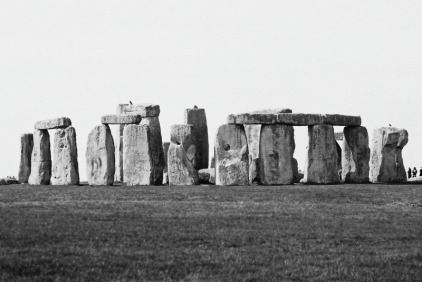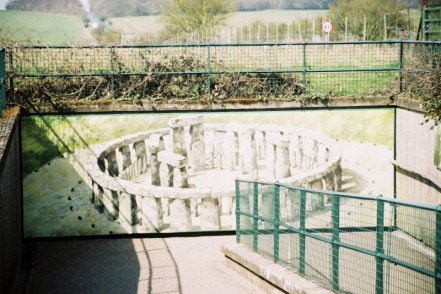Staged authenticity?
Who exactly built Stonehenge and why is still a mystery. It was proven that the inner stones of the circle are aligned with the midsummer and midwinter solstices, and that it is therefore very likely that it was used to mark to passage of the sun. It might also have been a place of worship, and there are several burial mounds nearby.
Stonehenge was built between 3000 BC and 2000 BC. For a long time, starting in medieval times, it was believed that Druids or other people with magical powers – from giants to Merlin – built the stone circle. However, the ancient Druids only flourished in the Iron Age, about 1.500 years after the structure was completed and before the Romans arrived in 43 AD. Today’s Druids are a re-invention of the old faith. Magic or pagan circles and convents occasionally use Stonehenge as their altar with the management’s permission. As these rites usually take place for sunrise, only invited visitors will see these rituals.
Many of these pagan groups claim that Stonehenge is located on a “power hot spot”, which adds energy to the rites and their performers, and also brings a peace and calm many of the partakers are looking for.
As nobody can be sure whether the site was actually used for such rites in prehistoric times, or whether the rituals performed today would have been the same all these centuries ago, these worship gatherings are staged events. Although the participants share a common faith, they also know that they have adapted Stonehenge for their purposes. Therefore no ritual can ever be truly authentic. But the worshippers know this and play along with the thought.
By far the most important worship event at Stonehenge is the summer solstice on June 24. Here again it is unknown how the ancient civilizations would have celebrated, so the whole ceremony is a staged event, although converted to fit in with modern-day practice, which makes it quasi-authentic.
Unless they have booked tickets for the solstice sunrise or any other ceremony, day visitors are unlikely to encounter these rituals, or see worshippers dressed in robes. However, educational visits for local primary school children often include them dressing up in robes, re-enacting pilgrimages to Stonehenge (as it is believed they might have happened) and visits might even include learning about the different tools used in prehistoric times.
At the underpass, a mural depicts a complete Stonehenge, as it might have looked before some of the stones tumbled, eroded or have been taken away. Here again, it is an artist’s impression of Stonehenge, as nobody living today will have seen it complete. The interpretations of the stones – for example one of the fallen stones was labeled Slaughter Stone, although it was just an upright that had fallen over and no research ever found it was used as an altar or to prepare sacrifices – are based on educated guesses and assumptions.
Stonehenge was built between 3000 BC and 2000 BC. For a long time, starting in medieval times, it was believed that Druids or other people with magical powers – from giants to Merlin – built the stone circle. However, the ancient Druids only flourished in the Iron Age, about 1.500 years after the structure was completed and before the Romans arrived in 43 AD. Today’s Druids are a re-invention of the old faith. Magic or pagan circles and convents occasionally use Stonehenge as their altar with the management’s permission. As these rites usually take place for sunrise, only invited visitors will see these rituals.
Many of these pagan groups claim that Stonehenge is located on a “power hot spot”, which adds energy to the rites and their performers, and also brings a peace and calm many of the partakers are looking for.
As nobody can be sure whether the site was actually used for such rites in prehistoric times, or whether the rituals performed today would have been the same all these centuries ago, these worship gatherings are staged events. Although the participants share a common faith, they also know that they have adapted Stonehenge for their purposes. Therefore no ritual can ever be truly authentic. But the worshippers know this and play along with the thought.
By far the most important worship event at Stonehenge is the summer solstice on June 24. Here again it is unknown how the ancient civilizations would have celebrated, so the whole ceremony is a staged event, although converted to fit in with modern-day practice, which makes it quasi-authentic.
Unless they have booked tickets for the solstice sunrise or any other ceremony, day visitors are unlikely to encounter these rituals, or see worshippers dressed in robes. However, educational visits for local primary school children often include them dressing up in robes, re-enacting pilgrimages to Stonehenge (as it is believed they might have happened) and visits might even include learning about the different tools used in prehistoric times.
At the underpass, a mural depicts a complete Stonehenge, as it might have looked before some of the stones tumbled, eroded or have been taken away. Here again, it is an artist’s impression of Stonehenge, as nobody living today will have seen it complete. The interpretations of the stones – for example one of the fallen stones was labeled Slaughter Stone, although it was just an upright that had fallen over and no research ever found it was used as an altar or to prepare sacrifices – are based on educated guesses and assumptions.


